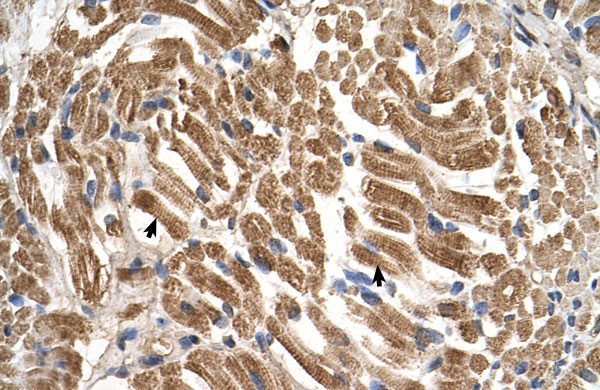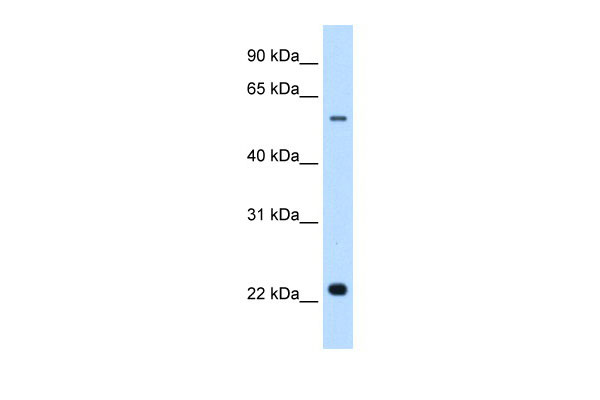SLC17A5 antibody - N-terminal region
Rabbit Polyclonal Antibody
- 产品详情
- 实验流程
Application
| WB, IHC |
|---|---|
| Primary Accession | Q9NRA2 |
| Other Accession | NM_012434, NP_036566 |
| Reactivity | Human, Mouse, Rat, Rabbit, Zebrafish, Pig, Dog, Guinea Pig, Horse, Bovine, Sheep |
| Predicted | Human, Rat, Rabbit, Zebrafish, Chicken, Dog, Guinea Pig, Horse |
| Host | Rabbit |
| Clonality | Polyclonal |
| Calculated MW | 54640 Da |
| Gene ID | 26503 |
|---|---|
| Alias Symbol | AST, FLJ22227, FLJ23268, ISSD, NSD, SD, SIALIN, SIASD, SLD |
| Other Names | Sialin, H(+)/nitrate cotransporter, H(+)/sialic acid cotransporter, AST, Membrane glycoprotein HP59, Solute carrier family 17 member 5, Vesicular H(+)/Aspartate-glutamate cotransporter, SLC17A5 |
| Format | Liquid. Purified antibody supplied in 1x PBS buffer with 0.09% (w/v) sodium azide and 2% sucrose. |
| Reconstitution & Storage | Add 50 ul of distilled water. Final anti-SLC17A5 antibody concentration is 1 mg/ml in PBS buffer with 2% sucrose. For longer periods of storage, store at 20°C. Avoid repeat freeze-thaw cycles. |
| Precautions | SLC17A5 antibody - N-terminal region is for research use only and not for use in diagnostic or therapeutic procedures. |
| Name | SLC17A5 |
|---|---|
| Function | Multifunctional anion transporter that operates via two distinct transport mechanisms, namely proton-coupled anion cotransport and membrane potential-dependent anion transport (PubMed:15510212, PubMed:21781115, PubMed:22778404, PubMed:23889254). Electroneutral proton-coupled acidic monosaccharide symporter, with a sugar to proton stoichiometry of 1:1. Exports glucuronic acid and free sialic acid derived from sialoglycoconjugate degradation out of lysosomes, driven by outwardly directed lysosomal pH gradient. May regulate lysosome function and metabolism of sialylated conjugates that impact oligodendrocyte lineage differentiation and myelinogenesis in the central nervous system (By similarity) (PubMed:15510212, PubMed:21781115, PubMed:22778404, PubMed:23889254). Electrogenic proton-coupled nitrate symporter that transports nitrate ions across the basolateral membrane of salivary gland acinar cells, with nitrate to proton stoichiometry of 2:1. May contribute to nitrate clearance from serum by salivary glands, where it is further concentrated and secreted in the saliva (PubMed:22778404). Uses membrane potential to drive the uptake of acidic amino acids and peptides into synaptic vesicles. Responsible for synaptic vesicular storage of L-aspartate and L-glutamate in pinealocytes as well as vesicular uptake of N-acetyl-L- aspartyl-L-glutamate neuropeptide, relevant to aspartegic-associated glutamatergic neurotransmission and activation of metabotropic receptors that inhibit subsequent transmitter release (By similarity) (PubMed:21781115, PubMed:22778404, PubMed:23889254). |
| Cellular Location | Basolateral cell membrane; Multi-pass membrane protein. Cytoplasmic vesicle, secretory vesicle, synaptic vesicle membrane; Multi-pass membrane protein. Lysosome membrane; Multi-pass membrane protein |
| Tissue Location | In the adult, detected in placenta, kidney and pancreas. Abundant in the endothelial cells of tumors from ovary, colon, breast and lung, but is not detected in endothelial cells from the corresponding normal tissues (PubMed:10581036, PubMed:11751519) Highly expressed in salivary glands and liver, with lower levels of expression in brain, spleen kidney, muscle and pancreas. Expressed in acinar cells of salivary glands (at protein level) (PubMed:22778404) |
Research Areas
For Research Use Only. Not For Use In Diagnostic Procedures.
Application Protocols
Provided below are standard protocols that you may find useful for product applications.
REFERENCES
Myall,N.J.,(2007)Mol.Genet.Metab.92(4),371-374ReconstitutionandStorage:Forshorttermuse,storeat2-8Cupto1week.Forlongtermstorage,storeat-20Cinsmallaliquotstopreventfreeze-thawcycles.
终于等到您。ABCEPTA(百远生物)抗体产品。
点击下方“我要评价 ”按钮提交您的反馈信息,您的反馈和评价是我们最宝贵的财富之一,
我们将在1-3个工作日内处理您的反馈信息。
如有疑问,联系:0512-88856768 tech-china@abcepta.com.























 癌症的基本特征包括细胞增殖、血管生成、迁移、凋亡逃避机制和细胞永生等。找到癌症发生过程中这些通路的关键标记物和对应的抗体用于检测至关重要。
癌症的基本特征包括细胞增殖、血管生成、迁移、凋亡逃避机制和细胞永生等。找到癌症发生过程中这些通路的关键标记物和对应的抗体用于检测至关重要。 为您推荐一个泛素化位点预测神器——泛素化分析工具,可以为您的蛋白的泛素化位点作出预测和评分。
为您推荐一个泛素化位点预测神器——泛素化分析工具,可以为您的蛋白的泛素化位点作出预测和评分。 细胞自噬受体图形绘图工具为你的蛋白的细胞受体结合位点作出预测和评分,识别结合到自噬通路中的蛋白是非常重要的,便于让我们理解自噬在正常生理、病理过程中的作用,如发育、细胞分化、神经退化性疾病、压力条件下、感染和癌症。
细胞自噬受体图形绘图工具为你的蛋白的细胞受体结合位点作出预测和评分,识别结合到自噬通路中的蛋白是非常重要的,便于让我们理解自噬在正常生理、病理过程中的作用,如发育、细胞分化、神经退化性疾病、压力条件下、感染和癌症。







